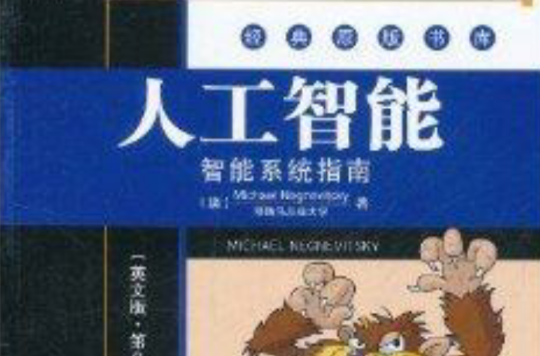《人工智慧:智慧型系統指南(英文版)(第3版)》主要內容簡介:人工智慧經常被人們認為是計算機科學中一門高度複雜甚至令人生畏的學科,、長期以來人工智慧方面的書籍往往包含複雜矩陣代數和微分方程、《人工智慧:智慧型系統指南(英文版)(第3版)》基於作者多年來給沒有多少微積分知識的學生授課時所用的講義,假定讀者沒有編程經驗,以簡單易懂的方式介紹了智慧型系統的基礎知識。《人工智慧:智慧型系統指南(英文版)(第3版)》目前已經被國際上多所大學(例如,德國的馬格德堡大學、日本的廣島大學、美國的波士頓大學和羅切斯特理工學院等)採納為教材。如果您正在尋找關於人工智慧或智慧型系統設計課程的淺顯易懂的入門級教材,如果您不是計算機科學領域的專業人員而又正在尋找介紹基於知識系統最新技術發展的自學指南,《人工智慧:智慧型系統指南(英文版)(第3版)》將是您的最佳選擇。與上一版相比,本版進行了全面更新,以反映人工智慧領域的最新進展。其中新增了數據挖掘與知識發現一章和自組織神經網路聚類一節內容,同時補充了4個新的案例研究。
基本介紹
- 書名:經典原版書庫:人工智慧:智慧型系統指南
- 作者:尼格尼維斯基(Michael Negnevitsky)
- 出版日期:2011年9月1日
- 語種:英語
- ISBN:9787111358220, 7111358228
- 外文名:Artificial Intelligence:A Guide to Intelligent Systems,Third Edition
- 出版社:機械工業出版社
- 頁數:479頁
- 開本:32
- 品牌:機械工業出版社
基本介紹,內容簡介,作者簡介,圖書目錄,
基本介紹
內容簡介
《人工智慧:智慧型系統指南(英文版)(第3版)》為經典原版書庫之一。
作者簡介
作者:(澳大利亞)尼格尼維斯基 (Michael Negnevitsky)
圖書目錄
Preface
Preface to the third edition
Overview of the book
Acknowledgements
1 Introduction to knowledge-based intelligent systems
1.1 Intelligent machines, or what machines can do
1.2 The history of artificial intelligence, or from the 'Dark Ages' to knowledge-based systems
1.3 Summary
Questions for review
References
Rule-based expert systems
2.1 Introduction, or what is knowledge?
2.2 Rules as a knowledge representation technique
2.3 The main players in the expert system development team
2.4 Structure of a rule-based expert system
2.5 Fundamental characteristics of an expert system
2.6 Forward chaining and backward chaining inference techniques
2.7 MEDIA ADVISOR: a demonstration rule-based expert system
2.8 Conflict resolution
2.9 Advantages and disadvantages of rule-based expert systems
2.10 Summary
Questions for review
References
Uncertainty management in rule-based expert systems
3.1 Introduction, Or what is uncertainty?
3.2 Basic probability theory
3.3 Bayesian reasoning
3.4 FORECAST: Bayesian accumulation of evidence
3.5 Bias of the Bayesian method
3.6 Certainty factors theory and evidential reasoning
3.7 FORECAST: an application of certainty factors
3.8 Comparison of Bayesian reasoning and certainty factors
3.9 Summary
Questions for review
References
Fuzzy expert systems
4.1 Introduction, or what is fuzzy thinking?
4.2 Fuzzy sets
4.3 Linguistic variables and hedges
4.4 Operations of fuzzy sets
4.5 Fuzzy rules
4.6 Fuzzy inference
4.7 Building a fuzzy expert system
4.8 Summary
Questions for review
References
Bibliography
Frame-based expert systems
5.1 Introduction, or what is a frame?
5.2 Frames as a knowledge representation technique
5.3 Inheritance in frame-based systems
5,4 Methods and demons
5.5 Interaction of frames and rules
5.6 Buy Smart: a frame-based expert system
S.? Summary
Questions for review
References
Bibliography
6 Artificial neural networks
6.1 Introduction, or how the brain works
6.2 The neuron as a simple computing element
6.3 The perceptron
6.4 Multilayer neural networks
6.5 Accelerated learning in multilayer neural networks
6.6 The Hopfield network
6.7 Bidirectional associative memory
6.8 Self-organising neural networks
6.9 Summary
Questions for review
References
Evolutionary computation
7.1 Introduction, or can evolution be intelligent?
7.2 Simulation of natural evolution
7.3 Genetic algorithms
……
Hybrid intelligent systems
Knowledge engineering
Data mining and knowledge discovery
Glossary
Appendix: AI tools and vendors
Index
Preface to the third edition
Overview of the book
Acknowledgements
1 Introduction to knowledge-based intelligent systems
1.1 Intelligent machines, or what machines can do
1.2 The history of artificial intelligence, or from the 'Dark Ages' to knowledge-based systems
1.3 Summary
Questions for review
References
Rule-based expert systems
2.1 Introduction, or what is knowledge?
2.2 Rules as a knowledge representation technique
2.3 The main players in the expert system development team
2.4 Structure of a rule-based expert system
2.5 Fundamental characteristics of an expert system
2.6 Forward chaining and backward chaining inference techniques
2.7 MEDIA ADVISOR: a demonstration rule-based expert system
2.8 Conflict resolution
2.9 Advantages and disadvantages of rule-based expert systems
2.10 Summary
Questions for review
References
Uncertainty management in rule-based expert systems
3.1 Introduction, Or what is uncertainty?
3.2 Basic probability theory
3.3 Bayesian reasoning
3.4 FORECAST: Bayesian accumulation of evidence
3.5 Bias of the Bayesian method
3.6 Certainty factors theory and evidential reasoning
3.7 FORECAST: an application of certainty factors
3.8 Comparison of Bayesian reasoning and certainty factors
3.9 Summary
Questions for review
References
Fuzzy expert systems
4.1 Introduction, or what is fuzzy thinking?
4.2 Fuzzy sets
4.3 Linguistic variables and hedges
4.4 Operations of fuzzy sets
4.5 Fuzzy rules
4.6 Fuzzy inference
4.7 Building a fuzzy expert system
4.8 Summary
Questions for review
References
Bibliography
Frame-based expert systems
5.1 Introduction, or what is a frame?
5.2 Frames as a knowledge representation technique
5.3 Inheritance in frame-based systems
5,4 Methods and demons
5.5 Interaction of frames and rules
5.6 Buy Smart: a frame-based expert system
S.? Summary
Questions for review
References
Bibliography
6 Artificial neural networks
6.1 Introduction, or how the brain works
6.2 The neuron as a simple computing element
6.3 The perceptron
6.4 Multilayer neural networks
6.5 Accelerated learning in multilayer neural networks
6.6 The Hopfield network
6.7 Bidirectional associative memory
6.8 Self-organising neural networks
6.9 Summary
Questions for review
References
Evolutionary computation
7.1 Introduction, or can evolution be intelligent?
7.2 Simulation of natural evolution
7.3 Genetic algorithms
……
Hybrid intelligent systems
Knowledge engineering
Data mining and knowledge discovery
Glossary
Appendix: AI tools and vendors
Index

